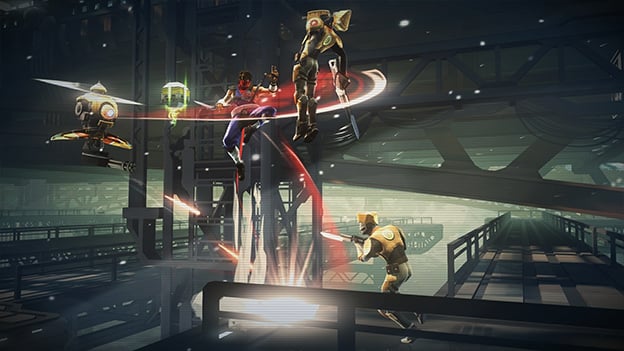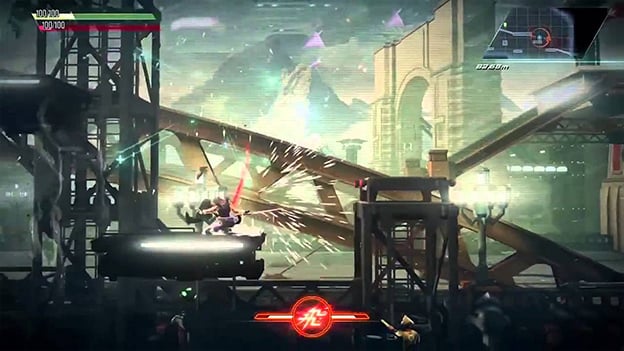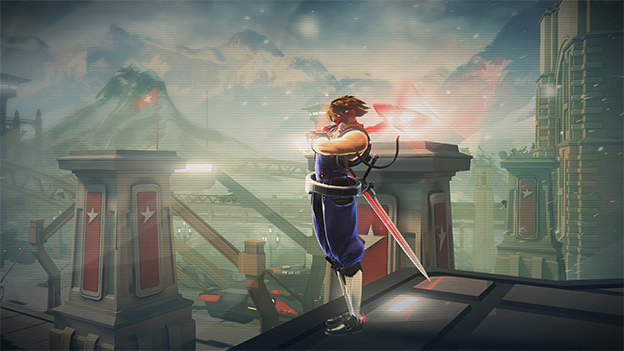This Is What Strider Was Born To Do
At this point, pretty much everyone knows who Strider Hiryu is due to his many appearances in the Marvel Vs. series. However, few people have actually played his original games, such as the weird open world platformer Strider on the NES, the magnificent 1989 arcade game, or the phenomenal Strider 2 for the PlayStation. That’s why Double Helix’s new Strider is such a magnificent game. It brings our favorite techno ninja back to his roots, the world of action platforming, while simultaneously paying homage to the many Strider games of the past. For many of us, this is our first introduction to classic Strider gameplay, but for the privileged few that have played the Strider games of the past, this is a love letter that celebrates all that Strider is, was, and will be.
If the metallic SCHWING of Strider’s cypher sword in the Vs. series pleases you, then you will be in absolute heaven here. Strider swings his sword fast and clean, just like a ninja should. He can swing it without stopping his momentum, and even aim his slashes. Like a rightful ninja, Strider can easily cut through legions of soldiers and enemy robots with ease. Many take only one hit to kill, allowing you to smoothly progress through the game unhindered, which actually makes the game quite appealing to speed runners. Basic combat in the game is fast and powerful and Strider usually has to deal with the sheer number of foes on the screen, rather than their power.
While the game has a few Metroidvania style free roaming segments, it’s mostly linear and stage based. Though you’ll have to backtrack and explore each level, Strider always seems to know exactly where he has to go next, and it’s pretty much your job to get him there unharmed. You’ll hang-glide, dash, wall and ceiling cling, slide, cartwheel and otherwise ninja your way through stages. Each of Strider’s moves are very fluid and are designed to keep you moving. Completionists will find interesting ways to use these moves to find hidden areas and secrets, while more straight forward gamers will use them to power through stages right to the end.

When Strider’s enemies get a bit too powerful for his simple cypher, Strider has a whole host of other robotic companions to call on. His robot panther and eagle, which you should also remember from the Vs. series, come back, and pack quite a punch. His little robot drones also come back, and yes, he does have access to the immensely powerful “ouroboros” technique which makes them shoot projectiles as he slashes. Most notably, these abilities aren’t just used for attacking enemies. Many times they are used in small puzzle segments. For example, his robot drones can hit switches from a long distance away.
Strider is also able to upgrade his sword over the course of the game as well. Usually, this involves giving the sword new properties, like fire or ice. While these upgrades are great for simply dealing out more damage and cutting your way through stages in a warpath of ninja glory, they are also used for puzzles as well. For example, the freeze blade can hold enemies in place and let you use them as platforms. This is instrumental in finding your way to secret areas. There are other blades that can hit enemy projectiles back at them, which many times is the most effective way to deal with them.

When Strider is powered up to the max, he truly does feel like an unstoppable cyber ninja, and that’s good. But the game doesn’t let you feel too invincible. As you grow in power, so do your enemies. More and more start being crammed on screen at the same time. There were points in Strider where it felt like I was in a bullet hell game instead of a platformer.
In fact, even the difficulty of Strider feels decidedly old school. The only way to restore your health Is by picking up health items. So if you are reckless with your life, you’ll find certain areas that are near impossible to get through. At the same time, however, you find yourself making choices as to whether or not you want to simply take damage and push through enemy forces or waste time killing them one by one. Sticking around a particularly difficult swarm of enemies may cause you to lose more life than simply taking a hit to the face and ignoring them all together. It feels a lot like NES Mega Man or Contra games in this way. There’s no handholding here.
In fact, there’s no place that the old school feel of the game becomes more apparent than when you face off against bosses. Bosses have truly massive amounts of health, and you are only going to defeat them with patience and accuracy. It’s a game of pattern memorization as you wait for the boss to throw the right attack that leaves them open for multiple strikes. Players who are more used to modern games with easier difficulties may find these bosses a bit off putting as you can easily die in only a couple of hits, but gamers who relish the feeling of a hard won victory over a difficult opponent will be in heaven here.

The presentation of Strider is truly top notch. The graphics are glorious and smooth, perfectly rendering enemies exploding into bits as Strider slashes through them. The environments are perfect, each of them a throwback to an old Strider stage both in design and in the background music. The voice actors are great too, if not a little hilarious. It feels like they are purposefully hamming it up at points, but that is part of what gives the game its old school charm.
There are a couple problems with Strider worth mentioning, however. First of all, it’s short. Casual players will beat it in 5-6 hours. Speed runners will likely blow through it in less than one. Some levels that we were shown as the game was being developed seem completely absent. Many enemies are reused from level to level and some levels do have a same-y feel to them. This doesn’t make the game get stale, but it does make slashing through the same enemies over and over again feel less thrilling.
But these are just nitpicks about a game that is otherwise pretty good. There aren’t a whole lot of hardcore action platformers out there these days, so Strider ’s release is a welcome boon to the hardcore crowd. You’ll love Strider if you like being challenged, but more importantly, you’ll like Strider if you are a Strider Hiryu fan, and there are a lot of those. At the very least, Strider is worth a try, and as long as you are OK with its short length, you should definitely pick it up.
RATING OUT OF 5 RATING DESCRIPTION 4.0 Graphics
While you can nitpick Strider’s character model or enemy designs, the game runs smooth and fast and that’s all that really matters. 5.0 Control
Perfect! Controlling a cyber ninja should feel exactly like this. 4.0 Music / Sound FX / Voice Acting
The soundtrack of classic Strider themes is a great throwback to the past. 3.5 Play Value
Strider is undoubtedly fun but it’s really depressingly short. 4.0 Overall Rating – Great
Not an average. See Rating legend below for a final score breakdown.
| Review Rating Legend | |||
|---|---|---|---|
| 0.1 – 1.9 = Avoid | 2.5 – 2.9 = Average | 3.5 – 3.9 = Good | 4.5 – 4.9 = Must Buy |
| 2.0 – 2.4 = Poor | 3.0 – 3.4 = Fair | 4.0 – 4.4 = Great | 5.0 = The Best |
Game Features:
